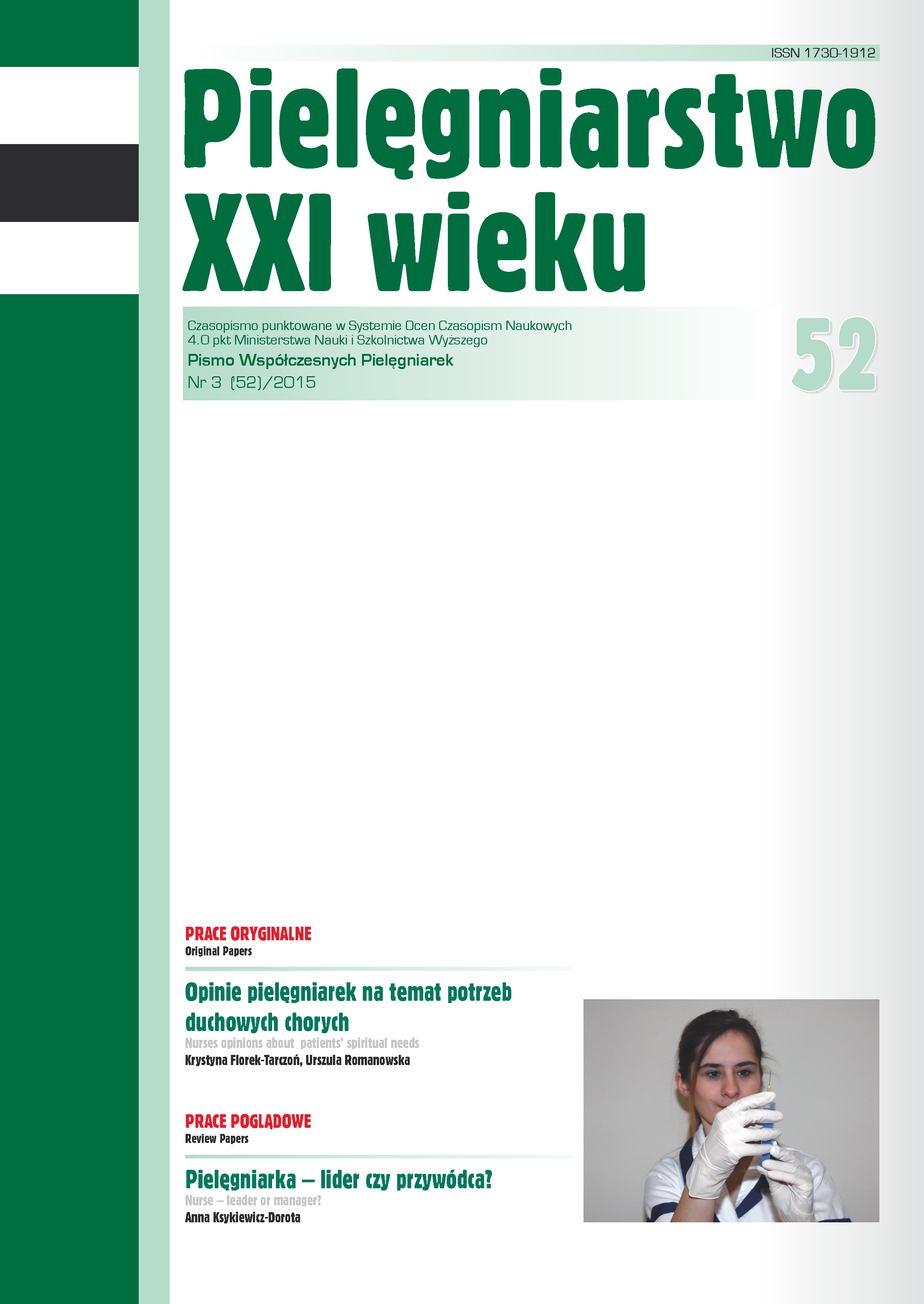The preparation of a selected parents population to take care of the child with asthma
DOI:
https://doi.org/10.12923/p21w-2015-3/31Keywords:
bronchial asthma, care, child, parents educationAbstract
THE PREPARATION OF A SELECTED PARENTS POPULATION TO TAKE CARE OF THE CHILD WITH ASTHMA
Aim of the Study. Asthma is considered as an increasingly frequent chronic disease affecting children and adults. Both the treatment processes and the overall progress in child treatment are hugely dependent on healthcare quality, as well as parents’ engagement.
Material and Methodology. The aim of the research was to look into the major problem concerning daily care and raising the awareness among parents of asthma in children. A questionnaire was handed out to parents of children diagnosed with asthma. The research was conducted at the Provincial Centre of Paediatrics “Kubalonka” in Istebna. The survey group consisted of 103 parents. The correlation and differences between groups were defined using the ANOVA analysis. The statistical analysis was conducted with STATISTICA 10.0.
Results. The findings of the study show that parents have sufficient knowledge about asthma and they tend to take the right measures aimed at eliminating allergens. Yet, there is a need to broaden the parents’ knowledge in the following fields: observation, early diagnosis, procedures in case of an exacerbation of the disease, as well as performing some breathing exercises.
References
1. Strzeciwko A, Kurpas D, Sochacka L. Dziecko i jego środowisko Wyzwania pediatrii w XXI wieku – choroby przewlekłe u dzieci. Wrocław: Continuo; 2009.
2. Bant A. Zalecenia Światowej Inicjatywy Zwalczania Astmy (GINA) 2006. Przew. Lek. 2007; (10): 25.
3. Komorowski J, Samoliński BK. Epidemiologia chorób alergicznych w Polsce i na świecie. Kształcenie podyplomowe. 2011; 4, (1); 22-30.
4. Łukasik R, Woś H. Problemy funkcjonowania dzieci z astmą oskrzelową w środowisku szkolnym. Probl. Pielg. 2009; 17 (1): 18-25.
5. Zubrzycka R, Emeryk A. Wpływ astmy oskrzelowej u dziecka na funkcjonowanie jego rodziny. Alerg. Astma Immunol. 2002; 7 (1): 21-26.
6. Fala A. red. Alergia, choroby alergiczne, astma. Kraków: Medycyna Praktyczna; 2010.
7. Palczewska I, Szilagyi-Pągowska I. Ocena rozwoju somatycznego dzieci i młodzieży. Med. Prakt. Ped. 2003; (3): 130-169.
8. Bożkowa K. Medycyna wieku rozwojowego. Warszawa: Instytut Matki i Dziecka. 2001; tom V.
9. Annett RD, Bender BG, Lapidus J, et al. Predicting children’s quality of life in an asthma clinical trial: what do children’s reports tell us? J. Pediatr. 2001; 139(6): 854-61.
10. Reichenberg K, Broberg AG. The Paediatric Asthma Caregiver’s Quality of Life Questionnaire in Swedish parents. Acta Paediatr. 2001; 90(1): 45-50.
11. Russell L. Putting schools to the test. Is your school prepared to manage your child’s asthma? Asthma Magazine. 2001; 24-26.
12. Korzekwa G, Obuchowicz A. The knowledge of parents of bronchial asthma children on the disease and management of a sick child. Polish J. of Environ Stud. 2008; 17 (4A): 214-219.
13. Adamska R, Dróżdż Z, Bręborowicz A, i wsp. Wykorzystywanie kwestionariusza PAQLQ w badaniu jakości życia dziecka z astmą oskrzelową. Pielęg. Pol. 2005; 1 (19): 22-26.
14. Feleszko W. Prewencja chorób alergicznych u dzieci. Post. Nauk Med. 2008; 21 (9): 606-610.
15. Gilliland F D, Berhane K, Islam T. i wsp. Obesity and the risk of newly diagnosed asthma in school-age children. Am. J. Epidemiol. 2003; 158: 406-415.
Downloads
Published
Issue
Section
License
Copyright (c) 2015 Teresa Olszańska, Jolanta Witanowska, Beata Jarecka (Autor)

This work is licensed under a Creative Commons Attribution-NonCommercial-NoDerivatives 3.0 Unported License.




